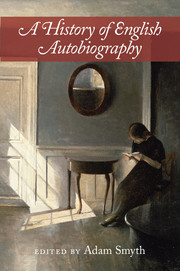Book contents
- Frontmatter
- Dedication
- Contents
- List of contributors
- 1 Introduction: The range, limits, and potentials of the form
- PART 1 AUTOBIOGRAPHY BEFORE ‘AUTOBIOGRAPHY’ (CA. 1300–1700)
- PART 2 RELIGION, GENDER, THINGS (CA. 1700–1800)
- PART 3 THE MANY NINETEENTH CENTURIES (CA. 1800–1900)
- 12 Working-class autobiography in the nineteenth century
- 13 Romantic life-writing
- 14 Nineteenth-century spiritual autobiography: Carlyle, Newman, Mill
- 15 Emerging selves: The autobiographical impulse in Elizabeth Barrett Browning, Anne Thackeray Ritchie, and Annie Wood Besant
- 16 Victorian artists’ autobiographies: Transgression, res gestae, and the collective life
- 17 Victorian print culture: Periodicals and serial lives, 1830–1860
- PART 4 RELATIONAL LIVES AND FORMS OF REMEMBERING (CA. 1890–1930)
- PART 5 KINDS OF COMMUNITY (CA. 1930-CONTEMPORARY)
- Index
- References
17 - Victorian print culture: Periodicals and serial lives, 1830–1860
from PART 3 - THE MANY NINETEENTH CENTURIES (CA. 1800–1900)
Published online by Cambridge University Press: 05 March 2016
- Frontmatter
- Dedication
- Contents
- List of contributors
- 1 Introduction: The range, limits, and potentials of the form
- PART 1 AUTOBIOGRAPHY BEFORE ‘AUTOBIOGRAPHY’ (CA. 1300–1700)
- PART 2 RELIGION, GENDER, THINGS (CA. 1700–1800)
- PART 3 THE MANY NINETEENTH CENTURIES (CA. 1800–1900)
- 12 Working-class autobiography in the nineteenth century
- 13 Romantic life-writing
- 14 Nineteenth-century spiritual autobiography: Carlyle, Newman, Mill
- 15 Emerging selves: The autobiographical impulse in Elizabeth Barrett Browning, Anne Thackeray Ritchie, and Annie Wood Besant
- 16 Victorian artists’ autobiographies: Transgression, res gestae, and the collective life
- 17 Victorian print culture: Periodicals and serial lives, 1830–1860
- PART 4 RELATIONAL LIVES AND FORMS OF REMEMBERING (CA. 1890–1930)
- PART 5 KINDS OF COMMUNITY (CA. 1930-CONTEMPORARY)
- Index
- References
Summary
In 1855, The Leisure Hour introduced several columns of extracts from the autobiography of the ‘American merchant’ Vincent Nolte by stating that ‘it may be taken as a rule, that all the world delights in a genuine autobiography’ (‘Passages’ 1855, 107). This weekly penny magazine was just one amongst the many newspapers and periodicals launched between 1830 and 1855 that were aimed at a new ‘mass’ audience of working- and lower-middle-class readers. The success of the so-called unstamped press during the 1820s had shown that it was possible for cheap newspapers and magazines retailing at between 1d and 3d to attract large audiences. The radical tone of much of the ‘unstamped’ led to the foundation of titles which aimed to give readers an alternative to political radicalism, such as Chambers's Edinburgh Journal (1832–1956) and the Penny Magazine (1832–1845), the latter funded by the Society for the Diffusion of Useful Knowledge (SDUK). These new titles regularly achieved circulations of more than 50,000 copies per week, although they were just as likely to end up in the homes of the middle class as on the tables of the working-class audience that they initially aimed to reach. By the late 1840s a new range of penny miscellanies, including The Family Herald (1843–1940), The London Journal (1845–1906), and Reynolds's Miscellany (1846–1869), had entered the marketplace for popular print. These titles blended illustrated fiction with short articles on a range of subjects and ‘answers to correspondents’ questions’ with astonishing success. Indeed, as Andrew King has argued, if Cassell's Illustrated Family Paper (1853–1932) is added to this list, the four most popular penny fiction weeklies were reaching ‘at least 50 per cent of the population of Britain’ by the mid 1850s (King 2008, 54).
Various forms of life-writing could regularly be found in these cheap publications. Some, including the ‘Chapter in the Life of a Poor Man’ that appeared in Chambers's Journal in 1841, were specially commissioned, but it was much more common for extensive passages from autobiographies to be reproduced as part of a review, or as an article that consisted of an abridgement of an existing (sometimes out of copyright) work. Such rewriting was often very creative.
- Type
- Chapter
- Information
- A History of English Autobiography , pp. 237 - 252Publisher: Cambridge University PressPrint publication year: 2016
References
- 1
- Cited by



